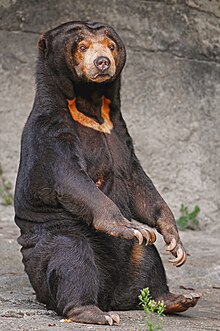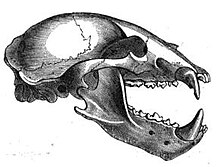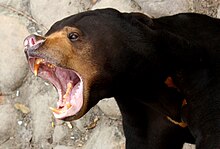Sun bear: Difference between revisions
Extended confirmed users, Pending changes reviewers 53,980 edits →Ecology and behaviour: extended with ref |
Extended confirmed users, Pending changes reviewers 53,980 edits →Conservation: extended with ref |
||
| Line 69: | Line 69: | ||
=== Conservation === |
=== Conservation === |
||
''Helarctos malayanus'' is listed on [[CITES Appendix I]] since 1979. Killing of sun bears is strictly prohibited under national wildlife protection laws throughout their range. However, little enforcement of these laws occurs.<ref name=iucn/> |
''Helarctos malayanus'' is listed on [[CITES Appendix I]] since 1979. Killing of sun bears is strictly prohibited under national wildlife protection laws throughout their range. However, little enforcement of these laws occurs.<ref name=iucn/> |
||
=== In captivity === |
|||
[[File:Sun Bear 3.jpg|thumb|left|A Malayan sun bear]] |
|||
The Malayan sun bear is part of an international captive breeding programme and has a [[SSP|Species Survival Program]] under the [[American Zoo and Aquarium Association]] since late 1994.<ref name=Ball2000>Ball, J. (2000). [http://www.nagonline.net/Fact%20Sheet%20pdf/AZA%20-%20Sun%20Bear%20Fact%20Sheet.pdf ''Sun Bear Fact Sheet'']. Woodland Park Zoo.</ref> |
|||
==References== |
==References== |
||
Revision as of 18:24, 7 February 2013
| Sun bear | |
|---|---|

| |
| Scientific classification | |
| Kingdom: | |
| Phylum: | Chordata |
| Class: | |
| Order: | |
| Family: | |
| Genus: | Helarctos Horsfield 1825
|
| Species: | H. malayanus
|
| Binomial name | |
| Helarctos malayanus (
Raffles , 1821) | |

| |
| Sun bear range (brown – extant, black – former, dark grey – presence uncertain) | |
| Synonyms | |
|
Ursus malayanus Raffles, 1821 | |
The sun bear (Helarctos malayanus) is a
The Malayan sun bears is also known as "honey bear", which refers to its voracious appetite for honeycombs and honey.[2]
Characteristics

The sun bear's fur is jet-black, short and sleek with some underwool. There are two whirls on the shoulders, from where the hair radiates in all directions. There is a crest on the sides of the neck and a whorl in the centre of the breast patch. There is always a more or less crescent-shaped pale patch on the breast that varies individually in colour ranging from buff, cream or dirty white to ochreous. The skin is naked on the upper lip. The tongue is long and protrusible. The ears are small and rounded, broad at the base and capable of very little movement. The front legs are somewhat bowed with the paws turned inwards, and the claws are black.[3]
The sun bear is the smallest of the bears. Adults are about 120–150 cm (47–59 in) long and weigh 27–65 kg (60–143 lb). Males are 10–20% larger than females. The muzzle is short and light coloured, and in most cases the white area extends above the eyes. The paws are large, and the soles are naked, which is thought to be an adaptation for climbing trees. The claws are large, curved and pointed.[4] They are sickle-shaped and relatively light in weight. The tail is 30–70 mm (1.2–2.8 in) long.[5]
Their sight is poor.[citation needed]
Distribution and habitat
Sun bears are found in the tropical rainforest of Southeast Asia ranging from north-eastern
Distribution of subspecies
- H. m. malayanus (Raffles, 1821) — inhabits Asian mainland and Sumatra;[6]
- H. m. euryspilus (Horsfield, 1825) — occurs only on the island of Borneo.[7]
Helarctos anmamiticus described by
Ecology and behaviour
As sun bears occur in tropical regions with year-round available foods, they do not hibernate. Except for females with their offspring, they are usually solitary.[1] Male sun bears are primarily diurnal, but some are active at night for short periods. Bedding sites consist mainly of fallen hollow logs, but they also rest in standing trees with cavities, in cavities underneath fallen logs or tree roots, and in tree branches high above the ground.[8]
In captivity they exhibit social behavior, and sleep mostly during the day.[9]
Diet

Sun bear scats collected in a Forest Reserve in
They can crack open nuts with their powerful
Reproduction
Females are observed to mate at about 3 years of age. During time of mating, the sun bear will show behaviour like hugging, mock fighting and head bobbing with its mate. After a gestation period of about 96 days, they can give birth to one or two cubs per year. Cubs are born blind and hairless, and weigh 300–400 g (0.66–0.88 lb). Initially, they are totally dependent on their mother, and suckle for about 18 months. After one to three months, the young can run, play and forage near their mother. They reach sexual maturity after 3–4 years and may live up to 30 years in captivity.[citation needed]
Threats
The two major threats to sun bears are habitat loss and commercial hunting. These threats are not evenly distributed throughout their range. In areas where deforestation is actively occurring, they are mainly threatened by the loss of forest habitat and forest degradation arising from clear-cutting for plantation development, unsustainable logging practices, illegal logging both within and outside protected areas and forest fires.[1]
The main predator of sun bears throughout its range is by far man. Commercial
Sometimes, sun bears are captured or bred to be domestic pets — a role for which they are considered desirable due to their relatively inoffensive nature and small size in comparison with other bears.[17]
Conservation
Helarctos malayanus is listed on
In captivity

The Malayan sun bear is part of an international captive breeding programme and has a
References
- ^ a b c d e f Template:IUCN
- ^ a b Lekagul, B. and J. A. McNeely (1977). Mammals of Thailand. Kurusapha Ladprao Press, Bangkok.
- ^ Pocock, R. I. (1941). The fauna of British India, including Ceylon and Burma. Mammalia. – Volume 2. Taylor and Francis, London.
- ^ a b Servheen, C. (1993). The Sun Bear. Pp. 124 in: Stirling, I., Kirshner, D., Knight, F. (eds.). Bears, Majestic Creatures of the Wild. Rodale Press, Emmaus, Pennsylvania.
- ISBN 1-55821-474-7.
- ^ a b Ellerman, J. R., Morrison-Scott, T. C. S. (1966). Checklist of Palaearctic and Indian mammals 1758 to 1946. Second edition. British Museum of Natural History, London. Page241.
- ^ Meijaard, E. (2004). Craniometric differences among Malayan sun bears (Ursus malayanus); Evolutionary and taxonomic implications. Raffles Bulletin of Zoology 52: 665–672.
- ^ Wong, S. T., Servheen, C. W., Ambu, L. (2004). Home range, movement and activity patterns, and bedding sites of Malayan sun bears Helarctos malayanus in the Rainforest of Borneo. Biological Conservation 119 (2): 169–181.
- ^ Wong, S. T (2011). "The Integration of Fulung and Mary". Borneo Sun Bear Conservation Center.
- ^ MacKinnon, K., Hattah, G., Halim, H., Mangalik, A. (1996). The ecology of Kalimantan, Indonesia Borneo. Periplus Editions, Hong Kong.
- ^ Wong, S. T., Servheen C., Ambu, L. (2002). "Food habits of Malayan Sun Bears in lowland tropical forests of Borneo" (PDF). Ursus. 13: 127–136.
{{cite journal}}: CS1 maint: multiple names: authors list (link) - ^ Augeri, D. M. (2005). On the Biogeographic Eology of the Malayan Sun Bear. PhD dissertation, Darwin College, Cambridge.
- ^ Meijaard, E. (1999). Human imposed threats to sun bears in Borneo. Ursus 11: 185–192.
- ^ Foley, K. E., Stengel, C. J. and Shepherd, C. R. (2011). Pills, Powders, Vials and Flakes: the bear bile trade in Asia. Traffic Southeast Asia, Petaling Jaya, Selangor, Malaysia.
- ^ Kawanishi, K. and M. E. Sunquist (2004). Conservation status of tigers in a primary rainforest of Peninsular Malaysia. Biological Conservation 120: 329–344.
- ^ Fredriksson, G. M. (2005). "Predation on Sun Bears by Reticulated Python in East Kalimantan, Indonesian Borneo" (PDF). Raffles Bulletin of Zoology. 53 (1): 165–168.
- ISBN 0-87196-871-1.
- ^ Ball, J. (2000). Sun Bear Fact Sheet. Woodland Park Zoo.

